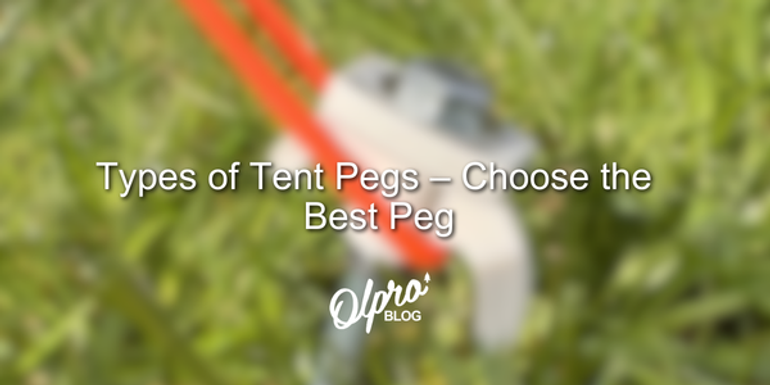Types of Tent Pegs – Choose the Best Peg
When it comes to securing your tent, choosing the best tent pegs for the ground type is crucial. Whether you're dealing with hard ground, soft soil, sand, or rocky terrain, selecting the right tent pegs ensures your tent stays secure in all weather conditions.
In this guide, we’ll explore the different types of tent pegs, their ideal uses, and how to choose the best tent pegs for hard ground, soft ground, and windy conditions. Whether you need hard ground pegs, sand tent pegs, or storm tent pegs, OLPRO has the perfect solution.
Do Tents Come with Pegs?
Yes, most tents come with basic steel pegs, but these are often not the best tent pegs for all ground types. Upgrading to rock tent pegs, hard ground tent pegs, or storm pegs can provide greater security, especially in extreme weather conditions.
For optimal stability, it's always recommended to invest in high-quality camping pegs for hard ground, soft ground, and other challenging terrains.
Different Types of Tent Pegs and Their Uses
1. Standard Steel Pegs – The Everyday Option
These pegs are lightweight and included with most tents. They work well in soft ground but struggle with hard-standing ground or rocky terrain.
- Best for: Soft soil, grass.
- Not ideal for: Hard ground, high winds.
- Recommended: OLPRO V Tent Pegs
2. Hard Ground Tent Pegs – Rock Pegs for Tough Terrain
If you're camping on hard ground or rocky surfaces, Hard Ground tent pegs are essential. Made from durable steel, they penetrate compacted soil without bending.
- Best for: Hard ground, gravel, rocky terrain.
- Not ideal for: Soft ground or sand.
- Recommended:OLPRO Hard Ground Pegs
3. Screw Pegs – The Best Tent Pegs for Windy Conditions
Screw pegs provide superior grip in various conditions. They twist into the ground for added stability, making them perfect as storm tent pegs.
- Best for: Hard standing ground, grass, strong winds.
- Not ideal for: Loose sand or mud.
- Recommended: OLPRO Screw in Hard Ground Pegs
4. Sand Tent Pegs – Ideal for Beaches and Soft Ground
Camping on the beach? Sand tent pegs are wider, offering better grip in loose or sandy soil. They are often Y-shaped or V-shaped to increase surface area and hold.
- Best for: Sand, loose soil, beach camping.
- Not ideal for: Hard or rocky ground.
- Recommended: OLPRO Extra long 30cm Plastic Tent Pegs
5. Storm Pegs – The Best Tent Pegs for Windy Conditions
For extreme weather, storm tent pegs provide maximum stability. Their deep grip helps secure tents against strong winds and storms.
- Best for: Windy conditions, storms, rough weather.
- Not ideal for: Very soft ground.
- Recommended: OLPRO Extra Long and Strong 30cm Nylon Tent Peg
How to Choose the Best Tent Pegs for Hard Ground, Sand, and Windy Conditions
The right tent pegs for hard ground, soft ground, and sand depend on your campsite conditions. Here’s a guide:
| Ground Type | Recommended Pegs |
|---|---|
| Hard ground, gravel | Rock pegs, screw pegs, hard ground pegs |
| Soft soil, grass | Standard steel pegs, Y-shaped pegs |
| Sand, loose ground | Sand tent pegs, V-shaped pegs |
| Windy conditions | Screw pegs, storm tent pegs, hard ground pegs |
For the best camping experience, carry a mix of hard standing tent pegs, soft ground pegs, and storm pegs.
Tent Peg Accessories for Easy Camping
To make setting up and packing down easier, consider these essential tent peg accessories:
- Mallet with Peg Puller – Essential for hammering in and removing tough pegs.
- Tent Peg Puller – Makes removing pegs from hard ground effortless.
- Peg Storage Bag – Keeps your pegs organised for quick setup.
Final Thoughts – What Are the Best Tent Pegs?
The best tent pegs depend on the camping location. If you're camping on hard ground, go for rock tent pegs or screw pegs. For beach camping, opt for sand tent pegs. If you're expecting wind, storm tent pegs offer extra stability.
Browse OLPRO’s tent pegs collection today and ensure your tent stays secure on any terrain.


 Euro
Euro
 Swedish Krona
Swedish Krona
 Danish Krone
Danish Krone
 Norwegian Krone
Norwegian Krone
